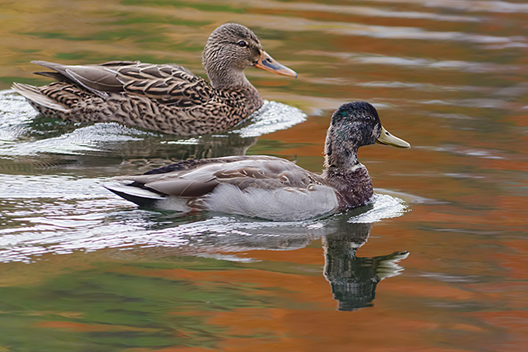Science Corner - Feather Weather

During a recent visit to the Woodland Regional Park Preserve (WRPP) I couldn’t help but notice a ring of floating feathers around the edge of the perennial wetland. Ahh, it’s feather weather! Adult waterfowl, primarily ducks and geese (swans, grebes, coots and other migrating species are often considered waterfowl as well) undergo two substantial and messy molting processes each year; a pre-basic or eclipse molt that results in basic or eclipse plumage and a pre-alternate or nuptial molt which results in breeding plumage. Since mallards are locally common and easily identifiable by their iridescent green heads and brassy personalities, we’ll focus on them.
Mallards (and all waterfowl), have three main types of feathers: flight feathers, contour feathers and down. The flight feathers are the big, strong quills in their wings and tail that generate lift and thrust. They support the bird during flight. Contour feathers are the feathers on the outside that give the bird shape and color. They overlap to shed moisture and to maintain heat. Down is found under the contour feathers and is fluffy. Down traps air and helps insulate, maintain buoyancy and aids in thermoregulation. All bird species lose worn or damaged feathers here and there and replace it with a brand new one in a process called molting. Most North American birds undergo sequential molting in which individual feathers are replaced one or two at a time leaving them relatively unaffected. Mallards (and all waterfowl) molt as well but if you’ve ever been stared down by protective momma goose or chased away by a lippy, territorial mallard, you might have guessed that their molting process is as shouty and dramatic as they are.
Unlike geese, Mallards don’t mate for life and form new pair bonds each breeding season. Once the breeding is complete and there’s no longer a need to impress females, the males drop all of their splashy, pretty feathers including those cute little curls just above their tails. The female also undergoes a basic molt but since her job is to keep the nest safe and hidden from predators, she never had the bright colors, and her molt is a little less dramatic. In addition to losing their bright feathers, both the hen and drake shed all of their flight feathers from their wings and tail simultaneously. This leaves them completely flightless for a period of three to five weeks until the new feathers replace the old ones. Being left flightless makes the birds especially vulnerable and susceptible to predation which is why the habitat adjacent to ponds and other wetlands is so important. The vegetation helps them hide and being near the water allows them to escape anything that can’t swim as fast or as efficiently as they can. Thankfully for the drake, he’s also lost all of his snazzy attention-grabbing feathers so he’s able to blend into the vegetation around the pond like the hen does. Mallards are dabbling ducks which means they graze vegetation and aquatic invertebrates off the bottom of the wetland. Therefore, finding food while flightless isn’t usually a problem for them. This is also why you may see them tipping forward with their bottoms to the sky while in the water.
Males being the showboats that they are, only retain their blah, basic plumage for a few weeks and often recoup their flamboyant green heads and curly tail feathers as early as October or November. This is why you see drakes in breeding plumage during the fall rather than late spring and summer when nesting and incubation is happening.
The nuptial or pre-alternate molt happens in late summer or early fall. This is when both the hen and the drake lose all of their dull, worn body feathers and replace them with fresh, undamaged feathers to help the bird stay warm and dry during the winter. The birds at WRPP are currently undergoing their pre-alternate molt which is why the perennial wetland is currently muddled with little floating feathers.
The process of molting is extremely important. Replacing old feathers with new ones not only improves efficiency in flight but it also helps them to maintain warmth and their waterproof coats. But replacing feathers costs ducks a lot of energy. The Audubon Society states that “molting is as energetically expensive as breeding and migrating, so the birds make sure that these three activities don’t overlap”. Molting and breeding occurs when there are abundant aquatic invertebrates available to help replace what their bodies have used to regrow their feathers. Understanding molting and different plumage seasons can help identify species and age of ducks and other birds based on where they are observed and when. Nature is so cool!
-Kristie Ehrhardt (kehrhardt@tuleyome.org)
Tuleyome Land Conservation Program Manager
RECENT ARTICLES






